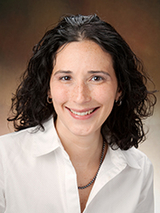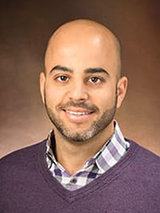At CHOP’s Suzi and Scott Lustgarten Center for GI Motility, our gastroenterologists, motility specialists and researchers have spent more than a decade working to:
- Identify new diagnostic tools and tests to help us better understand GI motility conditions and why they occur
- Trial cutting-edge technologies and procedures to address these chronic and debilitating conditions
- Offer effective and personalized treatments to children in our care

One of the strengths of CHOP’s GI motility program — and what sets us apart from other children’s hospitals in the nation — is CHOP’s ability to offer a full range of motility studies, diagnostic tests and treatments on-site, and our continued quest for new ways to improve children’s lives.
“Since GI disorders are influenced by a combination of different factors — genetics, biological and psychological characteristics, as well as social situations — it’s our responsibility to find out how the disorder is affecting a particular child and then develop a plan to treat or manage the symptoms,” says Kristin N. Fiorino, MD, pediatric gastroenterologist and clinical leader in CHOP’s Lustgarten Center for GI Motility.
Diagnosing a patient’s condition
CHOP offers a number of advanced diagnostic tools to help patients, families and referring physicians better understand the child’s condition and determine how to best treat it. Most testing is available through the Kohl’s GI Nutrition and Diagnostic Center, located on CHOP’s Philadelphia campus.
Depending on a child’s symptoms, diagnostic testing may include two novel and advanced tests to help clinicians better understand how a child’s esophagus, stomach and small bowel are processing foods.
- EndoFlip can provide details about the organs’ dimensions and pressure, helpful tools when planning treatment for conditions like eosinophilic esophagitis (EoE), achalasia and esophageal stricture. EndoFlip can be used as both a diagnostic tool and later to determine the effectiveness of treatment.
- EsoFlip allows clinicians to dilate the esophagus and examine it without using any radiation as they would need with standard imaging tests. In some cases, therapeutic dilation of the lower esophageal sphincter or esophageal strictures can act as a treatment to relieve symptoms.
We also offer a full range of manometric studies, including esophageal manometry and antroduodenal manometry, to measure how quickly foods are processed through the upper GI. Additional manometry testing available at CHOP can also help identify problems in the lower GI tract.
Other diagnostic tests, procedures and treatments offered at the Lustgarten Center for GI Motility include:
- Single- and double-balloon enteroscopy
- 24-hour and 48-hour pH-impedance monitoring
- Hydrogen breath testing
- Botox injections to halt overactive organs and allow food to pass through the body in a timely fashion
- Medications to manage symptoms
Our approach to treatment
CHOP offers a number of multidisciplinary clinics that work with the Lustgarten Center for GI Motility to help manage the care of children with specific motility issues. Each clinic includes a core team that includes a gastroenterologist with an expertise in motility issues in children, a psychologist, nurses and others.
Together, we work to uncover why a child has specific motility issues. Common causes include genetic conditions and birth anomalies. In many cases, the cause of motility issues is unknown, making treatment a bit more challenging as these disorders are largely symptom-based.
No matter the cause, our team of specialists work with families and partnering physicians to control troubling and disruptive symptoms so children can return to their daily activities with as few disruptions as possible.
Promising new research
While gastroenterologists like Dr. Fiorino work with patients and families, other members of the Motility team focus on clinical and translational research to develop better testing techniques, investigate new treatments and evaluate what’s working and what’s not. Leading that charge for the Lustgarten Center for GI Motility is Alain J. Benitez, MD, Director of Clinical Research.

While Dr. Benitez’s team is actively researching many aspects of GI motility disorders, a few specific conditions and tests/treatments rise to the top.
“We have a definite focus on esophageal disorders, with a special interest in how the lower esophageal sphincter may impact symptoms reported by patients with EoE and achalasia,” Dr. Benitez says. “We’re using EndoFlip technology to explore that and how effective the test may be in the pediatric setting to help us determine the severity of a child’s disease.”
Additional motility research currently underway at CHOP includes:
- Examining the effectiveness of EndoFlip and EsoFlip in a pediatric setting, e.g., how well do these diagnostic tools work in determining specific GI conditions in children, and evaluating the short- and long-term benefits of treatments
- Studying the use of new (or repurposed) medications to relive GI motility symptoms in children
- Exploring how an individual’s microbiome affects their symptoms or impacts GI motility
“At CHOP, we’re conducting research studies and providing medical and surgical management of GI motility conditions not available at any pediatric hospital in the U.S.,” Dr. Fiorino said. “Having all of that knowledge and all those resources in one institution allows us to collaborate better with referring physicians and, ultimately to better co-manage pediatric patients with motility concerns.”
Featured in this article
Specialties & Programs
At CHOP’s Suzi and Scott Lustgarten Center for GI Motility, our gastroenterologists, motility specialists and researchers have spent more than a decade working to:
- Identify new diagnostic tools and tests to help us better understand GI motility conditions and why they occur
- Trial cutting-edge technologies and procedures to address these chronic and debilitating conditions
- Offer effective and personalized treatments to children in our care

One of the strengths of CHOP’s GI motility program — and what sets us apart from other children’s hospitals in the nation — is CHOP’s ability to offer a full range of motility studies, diagnostic tests and treatments on-site, and our continued quest for new ways to improve children’s lives.
“Since GI disorders are influenced by a combination of different factors — genetics, biological and psychological characteristics, as well as social situations — it’s our responsibility to find out how the disorder is affecting a particular child and then develop a plan to treat or manage the symptoms,” says Kristin N. Fiorino, MD, pediatric gastroenterologist and clinical leader in CHOP’s Lustgarten Center for GI Motility.
Diagnosing a patient’s condition
CHOP offers a number of advanced diagnostic tools to help patients, families and referring physicians better understand the child’s condition and determine how to best treat it. Most testing is available through the Kohl’s GI Nutrition and Diagnostic Center, located on CHOP’s Philadelphia campus.
Depending on a child’s symptoms, diagnostic testing may include two novel and advanced tests to help clinicians better understand how a child’s esophagus, stomach and small bowel are processing foods.
- EndoFlip can provide details about the organs’ dimensions and pressure, helpful tools when planning treatment for conditions like eosinophilic esophagitis (EoE), achalasia and esophageal stricture. EndoFlip can be used as both a diagnostic tool and later to determine the effectiveness of treatment.
- EsoFlip allows clinicians to dilate the esophagus and examine it without using any radiation as they would need with standard imaging tests. In some cases, therapeutic dilation of the lower esophageal sphincter or esophageal strictures can act as a treatment to relieve symptoms.
We also offer a full range of manometric studies, including esophageal manometry and antroduodenal manometry, to measure how quickly foods are processed through the upper GI. Additional manometry testing available at CHOP can also help identify problems in the lower GI tract.
Other diagnostic tests, procedures and treatments offered at the Lustgarten Center for GI Motility include:
- Single- and double-balloon enteroscopy
- 24-hour and 48-hour pH-impedance monitoring
- Hydrogen breath testing
- Botox injections to halt overactive organs and allow food to pass through the body in a timely fashion
- Medications to manage symptoms
Our approach to treatment
CHOP offers a number of multidisciplinary clinics that work with the Lustgarten Center for GI Motility to help manage the care of children with specific motility issues. Each clinic includes a core team that includes a gastroenterologist with an expertise in motility issues in children, a psychologist, nurses and others.
Together, we work to uncover why a child has specific motility issues. Common causes include genetic conditions and birth anomalies. In many cases, the cause of motility issues is unknown, making treatment a bit more challenging as these disorders are largely symptom-based.
No matter the cause, our team of specialists work with families and partnering physicians to control troubling and disruptive symptoms so children can return to their daily activities with as few disruptions as possible.
Promising new research
While gastroenterologists like Dr. Fiorino work with patients and families, other members of the Motility team focus on clinical and translational research to develop better testing techniques, investigate new treatments and evaluate what’s working and what’s not. Leading that charge for the Lustgarten Center for GI Motility is Alain J. Benitez, MD, Director of Clinical Research.

While Dr. Benitez’s team is actively researching many aspects of GI motility disorders, a few specific conditions and tests/treatments rise to the top.
“We have a definite focus on esophageal disorders, with a special interest in how the lower esophageal sphincter may impact symptoms reported by patients with EoE and achalasia,” Dr. Benitez says. “We’re using EndoFlip technology to explore that and how effective the test may be in the pediatric setting to help us determine the severity of a child’s disease.”
Additional motility research currently underway at CHOP includes:
- Examining the effectiveness of EndoFlip and EsoFlip in a pediatric setting, e.g., how well do these diagnostic tools work in determining specific GI conditions in children, and evaluating the short- and long-term benefits of treatments
- Studying the use of new (or repurposed) medications to relive GI motility symptoms in children
- Exploring how an individual’s microbiome affects their symptoms or impacts GI motility
“At CHOP, we’re conducting research studies and providing medical and surgical management of GI motility conditions not available at any pediatric hospital in the U.S.,” Dr. Fiorino said. “Having all of that knowledge and all those resources in one institution allows us to collaborate better with referring physicians and, ultimately to better co-manage pediatric patients with motility concerns.”
Contact us
Suzi and Scott Lustgarten Center for GI Motility